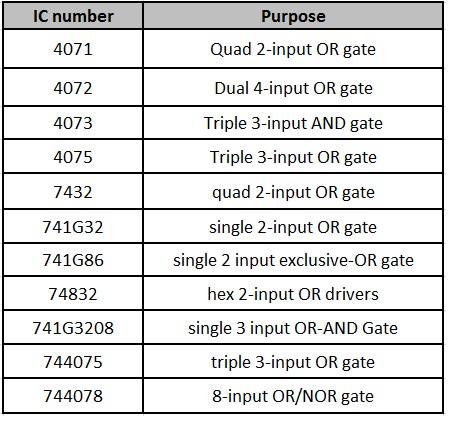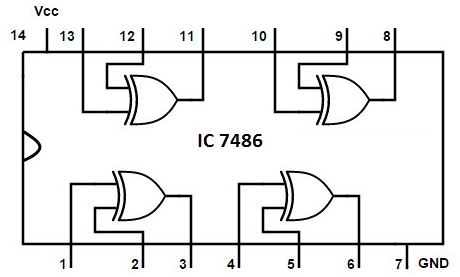Unlocking the Secrets of AND Gate IC Numbers: A Comprehensive Guide
Introduction
In the ever-evolving world of electronics, understanding the intricate details of integrated circuits (ICs) is essential. Among the myriad of ICs, the AND gate IC number holds a pivotal role. This article aims to demystify the AND gate IC numbers, providing you with a comprehensive understanding of their significance, applications, and more.
What is an IC?
Before delving into the specifics of AND gate IC numbers, let’s first clarify what an integrated circuit is. An integrated circuit, often referred to as an IC or microchip, is a tiny electronic device that contains a multitude of interconnected electronic components, such as transistors, resistors, and capacitors, all etched onto a single semiconductor chip. ICs serve as the building blocks of modern electronic devices, ranging from smartphones to computers and beyond.
The Fundamentals of AND Gates
To comprehend AND gate IC numbers, we must first grasp the basic concept of AND gates. An AND gate is a fundamental digital logic gate that performs a logical conjunction operation. It has two inputs and produces a single output, which is only “true” (or “high”) when both inputs are also “true.”
How AND Gates Work
Imagine two switches, A and B. To activate a light bulb, both switches must be in the “on” position. Similarly, an AND gate outputs a “high” signal only when both of its inputs are also “high.” If either input is “low,” the AND gate’s output will be “low.”
AND Gate IC Numbers Decoded
Now that we have a clear understanding of AND gates, let’s delve into the world of AND gate IC numbers.
What are AND Gate IC Numbers?
AND gate IC numbers, also known as IC part numbers or identifiers, are alphanumeric codes used to distinguish different types and variations of AND gate integrated circuits. These codes are essential for electronics engineers and enthusiasts when selecting the appropriate IC for a specific application.
Structure of AND Gate IC Numbers
AND gate IC numbers typically consist of several characters, each conveying specific information about the IC. Let’s break down a sample AND gate IC number, such as “74LS08.”
- 74: This part of the code usually represents the manufacturer’s identification or series number.
- LS: It signifies the logic family or technology used in the IC. In this case, “LS” represents Low-power Schottky.
- 08: The final digits indicate the specific function of the IC, in this case, an AND gate.
Applications of AND Gate IC Numbers
AND gate ICs find applications in various electronic circuits and systems. Here are some common uses:
1. Data Processing
AND gates play a crucial role in data processing circuits, where they are employed to filter and manipulate binary data.
2. Multiplexers
AND gate ICs are used in multiplexer circuits, allowing the selection of one of several input signals based on control inputs.
3. Address Decoding
In microcontrollers and memory systems, AND gate ICs are utilized for address decoding, enabling access to specific memory locations.
4. Digital Signal Processing
AND gates are integral in digital signal processing applications, performing logical operations on binary signals.
Choosing the Right AND Gate IC
Selecting the appropriate AND gate IC number is crucial for the success of your electronic project. Consider the following factors:
1. Voltage Requirements
Ensure that the IC operates within the voltage range of your application.
2. Speed and Delay
Different AND gate ICs have varying propagation delays. Choose one that suits your timing requirements.
3. Package Type
AND gate ICs are available in different packages, such as DIP and SMD. Pick the one that fits your circuit design.
Conclusion
In conclusion, AND gate IC numbers are the key to unlocking the potential of AND gate integrated circuits. These alphanumeric codes provide vital information about the IC’s manufacturer, technology, and function. Whether you’re a seasoned electronics engineer or a budding enthusiast, understanding AND gate IC numbers is essential for designing and building electronic circuits.
FAQs
- What is the difference between AND gates and OR gates?
- AND gates require all inputs to be true for the output to be true, whereas OR gates output true if any input is true.
- Can I use any AND gate IC for my project?
- No, you should select an AND gate IC that meets your project’s voltage, speed, and package requirements.
- Are AND gate ICs only used in digital electronics?
- While they are common in digital circuits, AND gate ICs can also find applications in analog signal processing.
- What are some other logic gate ICs besides AND gates?
- Some examples include OR gate ICs, NOT gate ICs, and XOR gate ICs.
- Where can I purchase AND gate ICs?
- You can find AND gate ICs at electronic component suppliers, both online and at physical stores.
Now that you’re well-versed in AND gate IC numbers, you’re ready to embark on your electronic ventures with confidence. Happy tinkering!
Typically, standard logic gates are available in pin or pin DIL (dual in line) chips. The number of gates per IC varies depending on the number of inputs per.
The AND gate is a basic digital logic gate that implements logical conjunction – it behaves. The function can be extended to any number of inputs. Small-scale integration (SSI).
Medium-scale integration (MSI).

Unlocking the Power of Standard Logic Gates: A Comprehensive Guide
In the world of digital electronics, standard logic gates are the building blocks that lay the foundation for complex circuitry. These essential components are typically available in pin or pin DIL (dual in line) chips, offering versatility and scalability to meet the demands of various applications. In this article, we will delve into the intricacies of standard logic gates, with a particular focus on the AND gate, exploring its functions and applications across different scales of integration.
Understanding the AND Gate
The AND gate is a fundamental digital logic gate that embodies logical conjunction. It is the gate that makes things happen when multiple conditions must be met for an action to occur. The beauty of the AND gate lies in its versatility, as it can accommodate any number of inputs, making it a crucial component in the world of digital logic.
Scaling Up: Integration Levels
Logic gates come in various integration levels, each suited to different tasks and complexities:
1. Small-Scale Integration (SSI)
SSI logic gates are your go-to choice for basic digital logic operations. These gates are perfect for simple tasks where only a few inputs need to be processed efficiently.
2. Medium-Scale Integration (MSI)
As your project grows in complexity, MSI logic gates step in to provide more capabilities. These gates are the bridge between basic operations and advanced functions, making them indispensable in numerous applications.
3. Large-Scale Integration (LSI)
When dealing with complex systems and intricate digital circuits, LSI logic gates shine the brightest. They are the powerhouse of digital electronics, offering a vast number of gates per IC to handle even the most intricate tasks.
Exploring the AND Gate in Action
To better understand the AND gate’s role in digital circuits, let’s take a look at its applications and where you can find them:
Blogger Spotlight: yuvi-studypoint
Visit yuvi-studypoint to explore in-depth information about AND gate logic IC products from TI. Stay updated with the latest developments and product releases in the world of digital logic.
Logic IC Datasheets and More
For comprehensive information on logic ICs, including datasheets and application notes, head over to TI’s official website. You can also request free samples to kickstart your digital projects.
Optimizing Gate Inputs
Efficiency is key when designing digital circuits. To avoid using an excessive number of ICs, consider optimizing your gate inputs or using alternative solutions. This strategic approach ensures your circuits remain streamlined and cost-effective.

Pin Arrangements and Documentation
Every IC comes with a specific pin arrangement, crucial for proper integration into your circuitry. Additionally, comprehensive documentation with brief notes is available for each IC, simplifying your design process.
Power Management
When working with logic gates, it’s vital to manage power effectively. ICs typically require a maximum current of approximately 5mA at 6V. This knowledge ensures your circuits operate efficiently and reliably.
Exploring Gate Varieties
The world of logic gates offers a diverse range of options to suit your project’s needs. Here are a couple of noteworthy examples:
Triple 3-Input AND Gate
This device boasts three independent gates, each capable of handling three inputs. It’s a versatile choice for various applications that demand precise logic operations.
Dual 4-Input NAND Gate
The 74HCTis a dual 4-Input NAND gate IC from the Logic Gate family ICs. It can process four logic inputs simultaneously, making it an efficient choice for complex tasks.
Endless Possibilities
In the realm of digital electronics, there’s virtually no limit to the number of gates that can be arrayed together within a single device. This flexibility allows you to tailor your circuits to your specific requirements, no matter how complex they may be.
Standardization and Beyond
IC packages and their standardization play a vital role in simplifying the integration of logic gates into your projects. With well-defined part numbering schemes, you can easily identify the right components for your needs, streamlining your design process.
Conclusion
In conclusion, standard logic gates, including the versatile AND gate, form the backbone of digital electronics. Whether you’re working on a simple project or a complex system, understanding the different scales of integration and optimizing your gate inputs are essential for success. By harnessing the power of logic gates, you can bring your digital creations to life with efficiency and precision.
